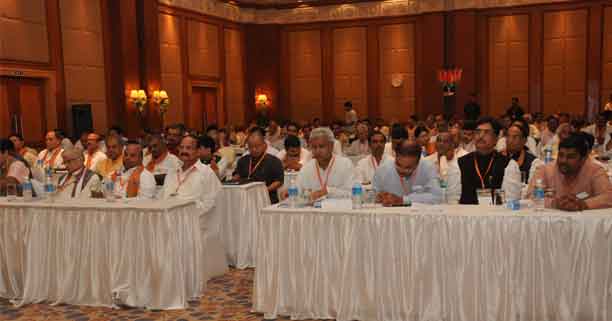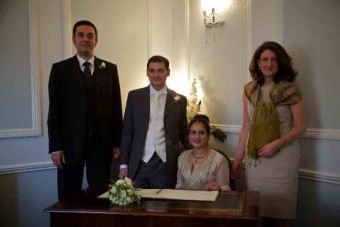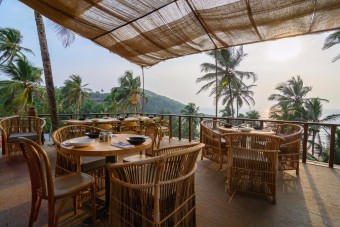BJP National Office Bearers meeting at Goa Marriott Resort & Spa
But will it last?
There’s one image that the BJP simply cannot shake off – that of being a Hindu nationalist party populated by right-wing ideologues. That’s not necessarily surprising for a party that owes its rise to the Hindutva movement and the campaign to build a temple in place of a mosque in Uttar Pradesh, touching massive rioting. Or for a party whose current leader has been criticized for extreme insensitivity towards the Muslim minority.
While the party subsequently tried to rebrand itself as a neoliberal champion of fast economic growth, a certain latent fear remains that all that’s just a mask for a more sinister agenda. Still, let’s face it. Here in Goa, like the rest of India, it’s abundantly clear that the BJP stands a better chance of winning national elections than any other party. It also seems clear that this is as much about people choosing a ‘lesser evil’ than any great adoration for the BJP.
“What works in favour of the BJP is that their candidates have a relatively clean image and the fact that their opponents are squabbling among themselves,” said Stephen Fernandes, a politically aware resident of North Goa.
He added, however, that several factors are working against the BJP, including the Modi factor, unease about the fact that the North Goa candidate in the April 12 Lok Sabha election is seeking a fourth term and a certain antipathy toward the state BJP government that has had two years now to take root.
Some of these factors, however, can work for the BJP, especially when it comes to Modi, who has quite a few local followers. Take the case of Goan bar owner Madhu Halarnkar. He swears by Modi but curses Goa’s chief Minister Manohar Parrikar as untruthful.
If you listen to the Facebook and Twitter chatter here in Goa, certain trends are unmistakeable. First, lots of people are warning that having the likes of Modi as Prime Minister of India could never be a good thing because of the perception both at home and abroad that he turned a blind eye to the bloody Gujarat rioting in 2002. Others, especially women, warn that voting in the BJP will turn back the clock on progressive causes, including women’s rights to do and wear what they want. A third group talks often on social media about the economic benefits of having a pro-business BJP in power.
The main problem with all this, of course, is that only a minority of Goans, perhaps 15 to 20 percent, have access to the internet, let alone Facebook and Twitter. And in a country like India, where educated folks spend a lot of time talking to each other online, it’s easy to forget that the electronic chatterati doesn’t necessarily have anything to do with the feelings, and voting habits, of the silent, unwired majority.
And that helps explain why the BJP might be doing a lot better in Goa – or perhaps a lot worse – than many of us think.
In Goa, the party consciously attempted rebranding in what has come to be known as the “Goa Model” – securing a majority in a state by actively engaging with minorities.
The party had a series of meetings with Church leaders in 2012 in a bid to break a predisposition against the BJP. And then they fielded six Catholic candidates on party tickets, an extraordinary move in a state where individuals have more pull than parties. That helped the party secure an absolute majority in the state assembly.
BJP leaders talk openly about using the Goa Model in other states where minorities hold sway and the party hasn’t been able to make much headway.
Caste also plays an important role in Goan elections. Tensions between the party’s North Goa candidate Shripad Naik, who hails from the lower Bahujan Samaj caste, and Parrikar, who’s from the upper Goud Saraswat Brahmin caste, at one point threatened to boil over into open hostility. Thankfully for the party, they have decided to keep differences aside and work to ensure a fourth term for Naik. In the south, the party’s candidate Narendra Sawoikar, hailing from an upper caste lineage, is unlikely to get many votes from the lower castes much less the tribals, who have decided to field their own candidate — Govind Gaude.
“I believe Shripad has the edge… Besides, the hate against Parrikar, if any for his misdeeds during the last two years will not rub off on Shripad Naik because Shripad comes from a different community. The Bahujan Samaj still hold Shripad in high regard,” said Prakash Sakhalkar, a tea stall owner in Panjim.
He added that Congress having chosen a ‘tainted candidate’ would work in favour of Shripad Naik.
Others, however, point to a combination of factors working against Shripad.
“Primary among them is the Modi factor. If you combine that with the resentment against Parrikar’s failed promises and weariness with Shripad who is now contesting for the fourth time, you have a combination of reasons that will play on the people’s mind. Given that people have an alternative in the AAP, they might exercise that option,” said a political analyst, who did not wish to be named on account of his proximity to senior BJP party leaders.
One thing that does seem clear, however, is that it will be easier to predict the outcome in the South than in the North, where a greater number of forces are still tugging for space.
Meanwhile the BJP hasn’t stopped courting the minorities, both here in Goa and in other Indian states. In the run-up to the election, Goa’s Catholic BJP MLAs are a big demand in the North Eastern states, where Christian populations are also sizeable. The intentions need no explaining. They want to show the ‘wary’ states that their party has room for everyone.
Paradoxically, it’s Modi himself who seems to be undermining those efforts. The strong Hindu overtones he emits – by avoiding the green attire associated with Islam and wearing either white or saffron, for instance – isn’t helping the party’s inclusive image it is trying to push.
For a state that has its fault lines clearly defined between the old Portuguese conquests – Bardes, Ilhas, Salcete including Mormugão – and the so-called new conquests, where Portuguese influence is less, polarization is something we can ill afford.
These fault lines have already made themselves known in the cases of the language and statehood agitations.
In the last elections the Goa Church urged its faithful to vote out corrupt leaders. This time it’s asking people to exercise their franchise “with a sense of responsibility to oneself and to our beloved nation, so that we may have a government which will uphold the principles of democracy, secularism, human rights, freedom of conscience, etc., as enshrined in the Constitution of our nation.”
BJP’s opponents have capitalized on statements like that, highlighting their “secular” status and repeatedly assuring that they will “take all communities along.”
The political movement has left the BJP’s Catholic candidates in a difficult spot. Most have chosen to stay out of the limelight, publicly pronouncing support while failing to hide their obvious unease.
Whether the Modi factor will work for or against the BJP remains to be seen, but the biggest source of uncertainty seems to be undecided voters – and whether they’ll choose to vote at all. Either way, it’s important to keep in mind our tiny state sends just two members to the 572-member house.
By Parrikar’s own admission “it won’t make or break a government at the centre.”




